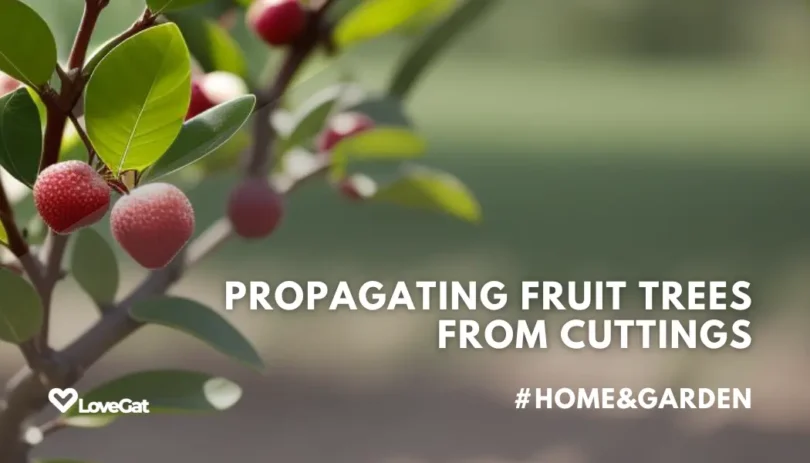Exploring the Possibility of Propagating Fruit Trees Through Cuttings!
Propagating fruit trees through cuttings is an intriguing method that offers potential advantages such as preserving desirable traits, accelerating growth, and producing true-to-type offspring. While it may seem daunting at first, with the right techniques and conditions, it’s entirely feasible to propagate fruit trees successfully. Let’s delve into the process and considerations involved in propagating fruit trees through cuttings:
Understanding the Process
1. Selection of Cuttings
-
Healthy Growth: Choose young, healthy branches from the current season’s growth for optimal success. Avoid using wood that is too young or too old, as it may not root properly.
-
Terminal vs. Lateral Cuttings: Terminal cuttings (taken from the tip of a branch) generally root more easily than lateral cuttings (taken from the side branches). However, both types can be successful with proper care.
2. Preparation of Cuttings
-
Cutting Length: Aim for cuttings that are 6 to 8 inches long, with several leaf nodes along the stem. Trim the cutting just below a node at the base and remove any leaves from the lower portion of the cutting.
-
Auxiliary Treatments: Some growers opt to apply rooting hormone to the base of the cutting to encourage root development. While not always necessary, rooting hormone can expedite the rooting process, especially for harder-to-root species.
3. Rooting Medium and Environment
-
Well-Drained Medium: Select a well-draining rooting medium like perlite, vermiculite, or a blend of peat moss and perlite. Maintain moisture consistently in the medium without overwatering.
-
Warm, Humid Environment: Place the cuttings in a warm, humid environment with indirect light to encourage root growth. Covering the cuttings with a plastic tent or placing them in a propagation tray with a humidity dome can help maintain high humidity levels.
4. Care and Maintenance
-
Regular Monitoring: Monitor the cuttings regularly for signs of rooting, such as new growth or resistance when gently tugged. Avoid disturbing the cuttings unnecessarily, as this can disrupt root formation.
-
Watering and Fertilization: Water the cuttings as needed to keep the rooting medium moist, but avoid overwatering, which can lead to rotting. Once rooted, gradually acclimate the cuttings to normal watering and fertilization practices.
Considerations for Success
1. Species Suitability
-
Varied Success Rates: Different fruit tree species and cultivars have varying degrees of success when propagated through cuttings. Some species root readily, while others may be more challenging.
-
Research and Experimentation: Conduct research or consult with experienced growers to determine which fruit tree species are best suited for propagation through cuttings. Consider experimenting with different varieties to gauge success rates.
2. Timing and Seasonality
-
Optimal Timing: The timing of taking cuttings can greatly influence their success. In general, softwood cuttings are taken in spring or early summer, while hardwood cuttings are taken in late fall or winter when the tree is dormant.
-
Seasonal Considerations: Pay attention to seasonal cues and environmental factors when propagating fruit trees through cuttings. Avoid taking cuttings during extreme heat or cold, as this can stress the plant and hinder rooting.
3. Disease and Pest Management
-
Sanitation Practices: Practice good sanitation when taking and handling cuttings to minimize the risk of disease transmission. Use clean, sharp tools, and avoid taking cuttings from diseased or pest-infested plants.
-
Preventative Measures: Consider treating cuttings with fungicides or insecticides as a preventative measure against diseases and pests. Monitor the cuttings regularly for signs of problems and take appropriate action if issues arise.
Propagating fruit trees through cuttings is a fascinating and rewarding endeavor that offers the potential to multiply desirable varieties and expand your orchard. While it requires careful attention to detail and adherence to proper techniques, the process can yield satisfying results with patience and perseverance. By understanding the principles involved, selecting suitable materials, and providing optimal growing conditions, you can explore the exciting possibility of propagating fruit trees through cuttings and enjoy the fruits of your labor for years to come.
You Might Also Like
- How I used AI to create a living data visualization for our home
- 20 Cool Home Decor And Designs For Any Style
- Planning a garden? Here’s a step-by-step guide to start off on the right foot
Social Media Communities
Share your digital nomad experiences and connect with fellow Us:
- Instagram: @Lovegatofficial
- Facebook: @LoveGat
Your journey doesn’t end here. Continue to explore and share our Decor & Home Posts.







